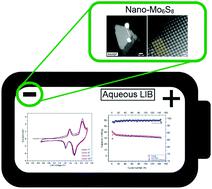Our official English website, www.x-mol.net, welcomes your feedback! (Note: you will need to create a separate account there.)
Nanocubes of Mo6S8 Chevrel phase as active electrode material for aqueous lithium-ion batteries
Nanoscale ( IF 6.7 ) Pub Date : 2022-06-23 , DOI: 10.1039/d2nr02014a Amr Elgendy 1, 2, 3 , Athanasios A Papaderakis 1, 2 , Rongsheng Cai 4 , Kacper Polus 5 , Sarah J Haigh 2, 4, 6 , Alex S Walton 1, 5 , David J Lewis 4 , Robert A W Dryfe 1, 2
Nanoscale ( IF 6.7 ) Pub Date : 2022-06-23 , DOI: 10.1039/d2nr02014a Amr Elgendy 1, 2, 3 , Athanasios A Papaderakis 1, 2 , Rongsheng Cai 4 , Kacper Polus 5 , Sarah J Haigh 2, 4, 6 , Alex S Walton 1, 5 , David J Lewis 4 , Robert A W Dryfe 1, 2
Affiliation

|
The development of intrinsically safe and environmentally sustainable energy storage devices is a significant challenge. Recent advances in aqueous rechargeable lithium-ion batteries (ARLIBs) have made considerable steps in this direction. In parallel to the ongoing progress in the design of aqueous electrolytes that expand the electrochemically stable potential window, the design of negative electrode materials exhibiting large capacity and low intercalation potential attracts great research interest. Herein, we report the synthesis of high purity nanoscale Chevrel Phase (CP) Mo6S8 via a simple, efficient and controllable molecular precursor approach with significantly decreased energy consumption compared to the conventional approaches. Physical characterization of the obtained product confirms the successful formation of CP-Mo6S8 and reveals that it is crystalline nanostructured in nature. Due to their unique structural characteristics, the Mo6S8 nanocubes exhibit fast kinetics in a 21 m lithium bis(trifluoromethanesulfonyl)imide (LiTFSI) electrolyte as a result of the shorter Li+ ion diffusion distance. Full battery cells comprised of Mo6S8 and LiMn2O4 as negative and positive electrode materials, respectively, operate at 2.23 V delivering a high energy density of 85 W h kg−1 (calculated on the total mass of active materials) under 0.2 C-rate. At 4 C, the coulombic efficiency (CE) is determined to be 99% increasing to near 100% at certain cycles. Post-mortem physical characterization demonstrates that the Mo6S8 anode maintained its crystallinity, thereby exhibiting outstanding cycling stability. The cell outperforms the commonly used vanadium-based (VO2 (B), V2O5) or (NASICON)-type LiTi2(PO4)3 anodes, highlighting the promising character of the nanoscale CP-Mo6S8 as a highly efficient anode material. In summary, the proposed synthetic strategy is expected to stimulate novel research towards the widespread application of CP-based materials in various aqueous and non-aqueous energy storage systems.
中文翻译:

Mo6S8 Chevrel相纳米立方体作为水系锂离子电池的活性电极材料
开发本质安全和环境可持续的储能装置是一项重大挑战。水性可充电锂离子电池 (ARLIB) 的最新进展已朝着这个方向迈出了相当大的一步。在设计扩大电化学稳定电位窗口的水性电解质方面取得进展的同时,具有大容量和低插层电位的负极材料的设计也引起了极大的研究兴趣。在此,我们报道了通过合成高纯度纳米级 Chevrel Phase (CP) Mo 6 S 8 一种简单、高效、可控的分子前体方法,与传统方法相比,能耗显着降低。所得产物的物理表征证实了CP-Mo 6 S 8的成功形成,并揭示了它本质上是晶体纳米结构。由于其独特的结构特性,Mo 6 S 8纳米立方体在 21 m 双(三氟甲磺酰)亚胺锂 (LiTFSI) 电解液中表现出较快的动力学,这是由于 Li +离子扩散距离较短。由 Mo 6 S 8和 LiMn 2 O 4组成的完整电池单元作为负极和正极材料,分别在 2.23 V 下工作,在 0.2 C 倍率下提供 85 W h kg -1的高能量密度(根据活性材料的总质量计算)。在 4 C 时,库仑效率 (CE) 确定为在某些循环中从 99% 增加到接近 100%。验尸物理表征表明,Mo 6 S 8阳极保持其结晶度,从而表现出出色的循环稳定性。该电池的性能优于常用的钒基(VO 2 (B)、V 2 O 5)或 (NASICON) 型 LiTi 2 (PO 4 ) 3阳极,突出了纳米级 CP-Mo 6 S 8作为高效阳极材料的前景。总之,所提出的合成策略有望激发新的研究,以推动基于 CP 的材料在各种水性和非水性储能系统中的广泛应用。
更新日期:2022-06-23
中文翻译:

Mo6S8 Chevrel相纳米立方体作为水系锂离子电池的活性电极材料
开发本质安全和环境可持续的储能装置是一项重大挑战。水性可充电锂离子电池 (ARLIB) 的最新进展已朝着这个方向迈出了相当大的一步。在设计扩大电化学稳定电位窗口的水性电解质方面取得进展的同时,具有大容量和低插层电位的负极材料的设计也引起了极大的研究兴趣。在此,我们报道了通过合成高纯度纳米级 Chevrel Phase (CP) Mo 6 S 8 一种简单、高效、可控的分子前体方法,与传统方法相比,能耗显着降低。所得产物的物理表征证实了CP-Mo 6 S 8的成功形成,并揭示了它本质上是晶体纳米结构。由于其独特的结构特性,Mo 6 S 8纳米立方体在 21 m 双(三氟甲磺酰)亚胺锂 (LiTFSI) 电解液中表现出较快的动力学,这是由于 Li +离子扩散距离较短。由 Mo 6 S 8和 LiMn 2 O 4组成的完整电池单元作为负极和正极材料,分别在 2.23 V 下工作,在 0.2 C 倍率下提供 85 W h kg -1的高能量密度(根据活性材料的总质量计算)。在 4 C 时,库仑效率 (CE) 确定为在某些循环中从 99% 增加到接近 100%。验尸物理表征表明,Mo 6 S 8阳极保持其结晶度,从而表现出出色的循环稳定性。该电池的性能优于常用的钒基(VO 2 (B)、V 2 O 5)或 (NASICON) 型 LiTi 2 (PO 4 ) 3阳极,突出了纳米级 CP-Mo 6 S 8作为高效阳极材料的前景。总之,所提出的合成策略有望激发新的研究,以推动基于 CP 的材料在各种水性和非水性储能系统中的广泛应用。



























 京公网安备 11010802027423号
京公网安备 11010802027423号